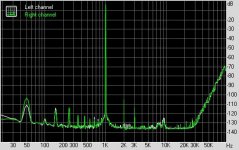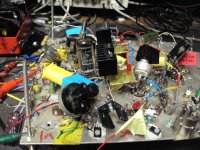I have used current sources and LM317s on tube cathodes and they are nasty.
I'd agree that the 317 as a cathode CCS is not a great choice. That's why I used a high performance discrete cascode. As rdf correctly points out, at AC, the CCS just gets out of the way- the interconnect and power amp input impedance are the actual load.
Heresey..?
Thats not heretical - taking the output from the grid in a cathode driven triode, now thats heresey 😉
Have fun
Owen
Thats not heretical - taking the output from the grid in a cathode driven triode, now thats heresey 😉
Have fun
Owen
SY,
Nelson Pass has a nice article up about feedback and distortion. The takeaway point being,
Cathode/Source followers are generally described as having 100% feedback. Does feedback=feedback here? That is, assuming that the Pass article is correct, would one expect this sort of harmonic spectrum from a cathode or source follower, or is there something different going on? I'll note that the F4 for instance is said to have 0 feedback, yet it looks more or less like a follower to me.
Nelson Pass has a nice article up about feedback and distortion. The takeaway point being,
while negative feedback reduces distortion, it creates additional higher order harmonics in the process.
Cathode/Source followers are generally described as having 100% feedback. Does feedback=feedback here? That is, assuming that the Pass article is correct, would one expect this sort of harmonic spectrum from a cathode or source follower, or is there something different going on? I'll note that the F4 for instance is said to have 0 feedback, yet it looks more or less like a follower to me.
That's a somewhat tricky one. The original Baxandall article in WW considered a device that had a pure second order transfer characteristic. Indeed, with the application of feedback, higher order harmonics are produced.
Here's the rub: no such device actually exists. If you apply small amounts of feedback to a real device, although THD may go down, higher order components may rise. Once feedback reaches a certain point, the spectrum is still more skewed to higher order products, but their amplitudes are lower. With LOTS of feedback, they can be made vanishingly small. No feeedback seems to be OK, lots of feedback seems to be OK, it's the small amounts of feedback where the trouble comes in, mainly reduction of second harmonic at the expense of increased higher order distortion.
For an ECC88 cathode follower, the maximum (100%) feedback is equivalent to about 31dB, a fairly healthy amount. As a result of this and the starting point (a very linear device), the distortion spectrum is ridiculously clean. The main issue with feedback is what happens at overload, but that's just not an issue here.
Here's the rub: no such device actually exists. If you apply small amounts of feedback to a real device, although THD may go down, higher order components may rise. Once feedback reaches a certain point, the spectrum is still more skewed to higher order products, but their amplitudes are lower. With LOTS of feedback, they can be made vanishingly small. No feeedback seems to be OK, lots of feedback seems to be OK, it's the small amounts of feedback where the trouble comes in, mainly reduction of second harmonic at the expense of increased higher order distortion.
For an ECC88 cathode follower, the maximum (100%) feedback is equivalent to about 31dB, a fairly healthy amount. As a result of this and the starting point (a very linear device), the distortion spectrum is ridiculously clean. The main issue with feedback is what happens at overload, but that's just not an issue here.
SY,
Nelson Pass has a nice article up about feedback and distortion. The takeaway point being,
Cathode/Source followers are generally described as having 100% feedback. Does feedback=feedback here? That is, assuming that the Pass article is correct, would one expect this sort of harmonic spectrum from a cathode or source follower, or is there something different going on? I'll note that the F4 for instance is said to have 0 feedback, yet it looks more or less like a follower to me.
One of my observations about Nelsons article is he specifically mentioned degeneration. He stated that there was no empirical evidence that it created higher order distortion. So degeneration may not equal feedback.
Therefore followers may be "feedback free".
YMMV
Doug
So degeneration may not equal feedback.
Therefore followers may be "feedback free".
A view on local degeneration I recall Allen Wright shares, though he still strictly avoids CFs.
One of my observations about Nelsons article is he specifically mentioned degeneration. He stated that there was no empirical evidence that it created higher order distortion. So degeneration may not equal feedback.
Therefore followers may be "feedback free".
YMMV
Doug
Although in a sense, that's a semantic argument, I would disagree that a cathode follower is any different than any other sort of negative feedback amplifier. The distortion reduction equation is the same and so are the results. And like any other feedback amplifier, careful attention must be paid to controlling the rolloffs and avoiding oscillation. There's an intuitive discomfort that many people have about loop feedback in multistage amplifiers, and some deep misunderstandings about causality. Nonetheless, in both multistage loop feedback and local degeneration, the distortion and noise are decreased in proportion to the gain reduction, and the bandwidth is likewise increased.
It's a distinction without a difference.
Allen uses CFs, he just bootstraps the plate. There are theoretical advantages to that, and he claims sonic ones, too. Having experimented with bootstrapping and not being impressed with the differences, I opt for a simpler circuit.
For an ultimate version of Allen's approach, check out the input stage of the Tektronix W plug in.
For an ultimate version of Allen's approach, check out the input stage of the Tektronix W plug in.
Allen uses CFs, he just bootstraps the plate.
Ya, I was focused on lease agreements and went a little too shorthand. Should have said classic CFs.
Re: degeneration vs. loop, not completely clear to me. Certainly the classic equations agree but they're greatly simplified and treat amplification stages as perfect gain. The questions come with deviation from that ideal and what happens when intermediate non-linear stages add distortion and noise to a multistage correction signal. Since in a CF the output signal directly - and therefore presumably perfectly - subtracts from the input grid-cathode voltage the correction signal is in a sense 'perfect'. Granted, I've spend more time on leases than theory lately.
But when you get down to it, the amp is just a box of gain with a transfer function whether there's one device inside or a hundred. It's immaterial how the transfer function got there, the distortion reduction is still the same. As Phil Lesh would have said,
'Cause it's just a box of gain
Doesn't matter what's in there.
If you feed it with a signal
and degenerate with care,
It will lose its voltage gain
but distortion will go down.
With a CS on the cathode
you will get a pleasing sound.
'Cause it's just a box of gain
Doesn't matter what's in there.
If you feed it with a signal
and degenerate with care,
It will lose its voltage gain
but distortion will go down.
With a CS on the cathode
you will get a pleasing sound.
Here's the rub: no such device actually exists. If you apply small amounts of feedback to a real device, although THD may go down, higher order components may rise. Once feedback reaches a certain point, the spectrum is still more skewed to higher order products, but their amplitudes are lower. With LOTS of feedback, they can be made vanishingly small. No feeedback seems to be OK, lots of feedback seems to be OK, it's the small amounts of feedback where the trouble comes in, mainly reduction of second harmonic at the expense of increased higher order distortion.
I know: Lesh is right but missing the word "HF phase irregularities in harmonics with rising frequency" ..That hurts. .. I'm working on a simple tube version using EF184 as triode and ECC88 as final CF. It may take a long time with the correct components.
Some decades back, Neve solved it with SS EQ and went to fame. (of course much simpler). Now the obvious is to DSP'it. Nice progamming algorthim.
richy
Attachments
Having experimented with bootstrapping and not being impressed with the differences, I opt for a simpler circuit.
I presume that you didn't make the comparison with a particularly high source impedance or a large signal swing.
?
10 meg / 100 volt
No, I'm fresh out of CD players or FM tuners that have 10 meg source Z and 100V output.
A bootstrapped plate voltage takes Ca-g (which includes wiring and socket strays) out of the equation and improves the bandwidth with high source resistances. I got a significant improvement up in the MHz's out of my 6922 and the linearity prior to clipping was much better.
So there.
So there.
Last edited:
Well, remember that the source resistance is 5k max because of the volume control. Bandwidth is limited by the input transformer, and IMO, that's nothing but a good thing. I'm very skeptical about audible advantages of ultra-high bandwidth.
- Status
- Not open for further replies.
- Home
- Amplifiers
- Tubes / Valves
- A Heretical Unity Gain Line Stage part III

